The number of major cyberlaw and information tech policy books being published annually continues to grow at an astonishing pace, so much so that I have lost the ability to read and review all of them. In past years, I put together end-of-year lists of important info-tech policy books (here are the lists for 2008, 2009, 2010, and 2011) and I was fairly confident I had read just about everything of importance that was out there (at least that was available in the U.S.). But last year that became a real struggle for me and this year it became an impossibility. A decade ago, there was merely a trickle of Internet policy books coming out each year. Then the trickle turned into a steady stream. Now it has turned into a flood. Thus, I’ve had to become far more selective about what is on my reading list. (This is also because the volume of journal articles about info-tech policy matters has increased exponentially at the same time.)
So, here’s what I’m going to do. I’m going to discuss what I regard to be the five most important titles of 2012, briefly summarize a half dozen others that I’ve read, and then I’m just going to list the rest of the books out there. I’ve read most of them but I have placed an asterisk next to the ones I haven’t. Please let me know what titles I have missed so that I can add them to the list. (Incidentally, here’s my compendium of all the major tech policy books from the 2000s and here’s the running list of all my book reviews.)
As I do each year, I need to repeat a few disclaimers. First, what qualifies as an “important” info-tech policy book is highly subjective, but I would define it as a title that many people — especially scholars in the field — are currently discussing and that we will likely be referencing for many years to come. But I “weight” books in the sense that narrowly-focused titles lose a few points. For example, books that deal mostly with privacy issues, copyright law, or antitrust policy are docked a few points relative to “big picture” info-tech policy books that offer a broader exploration of policy issues and which offer more wide-ranging recommendations.
Second, almost all of the books included have something profound to say about Internet policy (either directly or indirectly) and the more profound and clear the policy recommendations or implications, the higher the titles rank in terms of importance on my list.
Third, and most importantly: Just because a book appears on this list that does not necessarily mean I agree with everything in it. In fact, as was the case in previous years, I found much with which to disagree in most of the books listed here. Simply put, the cyber-liberty I cherish is a real loser in both academic and public policy circles these days. It has very few defenders today. So, if this was simply a list of my personal favorite books, there would only be 2 or 3 titles on it. Instead, this is my effort to list important books in the field, regardless of whether I agree with the content and conclusions found in those titles.
OK, on to the list.
(1) Rebecca MacKinnon – Consent of the Network: The Worldwide Struggle for Internet Freedom
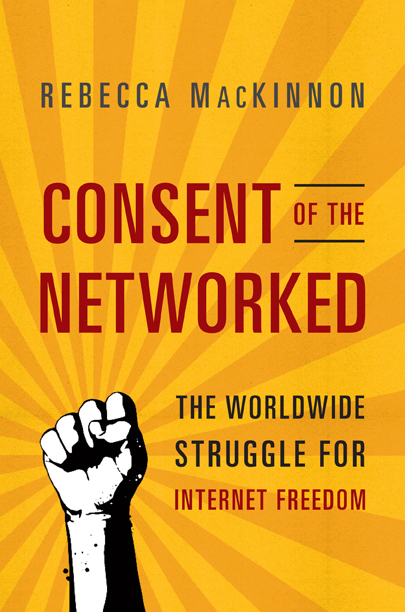 Rebecca MacKinnon’s book was the most important information technology policy book released in 2012 because it: (1) presented a splendid history of the ideas and forces shaping Internet policy debates globally; (2) offered policy insights that were extremely relevant to breaking developments in this field; and (3) set forth a call-to-arms to global Internet activists and gave them a new way of framing their issue advocacy.
Rebecca MacKinnon’s book was the most important information technology policy book released in 2012 because it: (1) presented a splendid history of the ideas and forces shaping Internet policy debates globally; (2) offered policy insights that were extremely relevant to breaking developments in this field; and (3) set forth a call-to-arms to global Internet activists and gave them a new way of framing their issue advocacy.
MacKinnon is a former journalist and her outstanding reporting skills are on display throughout the text. Her coverage of China’s efforts to regulate the Net is outstanding. She also surveys some of the recent policy fights here and abroad over issues such as online privacy, Net neutrality regulation, free speech matters, and the copyright wars. The book demands attention for this historical work and analysis alone.
Even more importantly, however, MacKinnon makes a forceful argument for how to think about Internet freedom and democracy in new digital worlds. Her book is an attempt to take the Net freedom movement to the next level; to formalize it and to put in place a set of governance principles that will help us hold the “sovereigns of cyberspace” more accountable. Many of her proposals are quite sensible. But, as I noted in my much longer review of the book, I had a real problem with MacKinnon’s use of the term “digital sovereigns” or “sovereigns of cyberspace” and the loose definition of “sovereignty” that pervades her narrative. She too often blurs and equates private power and political power, and she sometimes leads us to believe that the problem of the dealing with the mythical nation-states of “Facebookistan” and “Googledom” is somehow on par with the problem of dealing with actual sovereign power — government power — over digital networks, online speech, and the world’s Netizenry.
Despite these nitpicks, MacKinnon has many other ideas about Net governance in the book that are less controversial and entirely sensible in my opinion. She wants to “expand the technical commons” by building and distributing more tools to help activists and make organizations more transparent and accountable. These would include circumvention and anonymization tools, software and programs that allow both greater data security and portability, and devices and network systems to expand the range of communication and participation, especially in more repressed countries. She would also like to see neitzens “devise more systematic and effective strategies for organizing, lobbying, and collective bargaining with the companies whose service we depend upon — to minimize the chances that terms of service, design choices, technical decisions, or market entry strategies could put people at risk or result in infringement of their rights.” This also makes sense as part of a broader push for improved corporate social responsibility.
Regarding the role of law, MacKinnon has a mixed view. She says: “There is a need for regulation and legislation based on solid data and research (as opposed to whatever gets handed to legislative staffers by lobbyists) as well as consultation with a genuinely broad cross-section of people and groups affected by the problem the legislation seeks to solve, along with those likely to be affected by the proposed solutions.” Of course, that’s a fairly ambiguous standard that could open the door to excessive political meddling with the Net if we’re not careful. Overall, though, she acknowledges how regulation so often lags far behind innovation. “A broader and more intractable problem with regulating technology companies is that legislation appears much too late in corporate innovation and business cycles,” she rightly notes.
MacKinnon’s book will be of great interest to Internet policy scholars and students, but it is also accessible to a broader audience interested in learning more about the debates and policies that will shape the future of the Internet and digital networks for many years to come. One other note: MacKinnon’s clearly-worded prose and cool-headed tone deserve praise and emulation. It serves as a model for how to write a thoughtful Internet policy book, even if you don’t agree with all her conclusions or recommendations.
My complete review of Consent of the Networked can be found here.
(2) Susan Crawford – Captive Audience: The Telecom Industry and Monopoly Power in the New Gilded Age
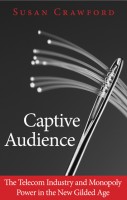 Susan Crawford’s book was probably my least favorite title of 2012, but that doesn’t mean I can discount its significance within this field. Crawford has made herself a widely-recognized and highly-charged figure in the world of Internet policy through her work as an activist, an academic, and even a government official. In Captive Audience, she doesn’t even try to hide her self-described “radicalized” views on communications policy anymore and in the process she solidifies her role as the ringleader of the growing movement to impose centralized, top-down government control on America’s broadband infrastructure.
Susan Crawford’s book was probably my least favorite title of 2012, but that doesn’t mean I can discount its significance within this field. Crawford has made herself a widely-recognized and highly-charged figure in the world of Internet policy through her work as an activist, an academic, and even a government official. In Captive Audience, she doesn’t even try to hide her self-described “radicalized” views on communications policy anymore and in the process she solidifies her role as the ringleader of the growing movement to impose centralized, top-down government control on America’s broadband infrastructure.
What is most astonishing about Captive Audience is the way Crawford so audaciously waxes nostalgic for the days of regulated monopoly. Simply put, Crawford doesn’t believe that capitalism or competition have any role to play in the provision of broadband networks and services. “No competitive pressure will force these companies to act [in the public interest],” she argues on the last page of the manifesto. “Americans,” she claims, “have allowed a naive belief in the power and beneficence of the free market to cloud their vision.” She suggests we should just give up our false hope that markets can deliver such an important service and get on with the task of converting broadband into a full-blown regulated public utility.
Her proposed solutions read like the typical Big Government grab-bag of policy proposals: more government spending, more government ownership, and more government regulation (forced access regulation and rate controls) for any private carriers that are allowed to remain in operation as de facto handmaidens of the state. Crawford’s perfect world scenario would seem to be some sort of amalgam of the U.S. Postal Service and the federal highway program. While both programs have sought to provide an important service to the masses, it goes without saying that both are also an absolute basket case in terms of service management and economic viability. But, for the sake of argument, let’s say that Crawford is right and that public ownership and comprehensive government management is the way to go. Where will all this money come from for all the new government activity Crawford desires? Apparently it grows on trees because she isn’t ever willing to admit that we find ourselves in the midst of major fiscal crisis that likely constrains the ability of governments to make these investments themselves. Luckily, private wireline and wireless broadband providers have been investing tens of billions in infrastructural upgrades in recent years (don’t take my word for it, read what the Progressive Policy Institute has to say), a fact that Crawford conveniently ignores.
More importantly, Crawford never fully confronts the fact that the era of regulated monopoly she cherishes was an unmitigated croynist disaster for consumers. That era had nothing to do with the “public interest” and everything to do with protecting the private interests of regulated entities — namely, Ma Bell on the communications side and broadcasters on the media side. She also doesn’t address the lackluster state of innovation during the 70 or so years during which time communications and media markets were under the tight grip of federal and state regulators, who controlled rates, restricted new entry, and discouraged innovation at virtually every juncture. If one is going to recommend a return to the regulatory past, they had better grapple with that uncomfortable, anti-consumer, anti-innovation history. Crawford utterly fails to in Captive Audience.
While the book is nominally about broadband regulation, the bulk of it is actually dedicated to taking on one company — Comcast — and specifically picking apart its recent merger with NBC Universal. For Crawford, the Comcast-NBC deal represented something akin to the Mayan apocalypse of media policy. She wants us to believe that the deal has forever solidified Comcast’s grasp on both programming and broadband markets. Comcast chief Brian Roberts is presented as the nefarious villain of the narrative; Crawford paints him as a cross between Gordon Gecko and Mr. Burns from “The Simpsons.” Usually such neurotic narratives are reserved for Rupert Murdoch and how he is supposedly plotting mass media domination to brainwash the minds of the masses. But Crawford suggests that Roberts is the new Bond villain du jour and chapter after chapter are devoted to demonizing him, his father, and other execs at Comcast. She argues that “Comcast now owns the Internet in America” and that the company is “squeezing independent online video” providers out of the market.
Despite all this hand-wringing, the situation in the video marketplace has never looked brighter. Crawford fails to put things in historical perspective and examine consumer choices in this market today relative to the past — a point I made in this debate with her last year. Of course, she probably didn’t want to seriously examine that evidence because by every metric available — and I published an entire report called Media Metrics a few years ago proving this — Americans have more and better viewing options at their disposal than ever before in history. We have more channels and more content available over more platforms (cable, satellite, telco, online, DVD, mail, etc) and more devices than ever before. Consumers have an unprecedented ability to access, record, time-shift, interact with, and even manipulate and redistribute video content. Of course, all this choice and quality comes at a cost, as Crawford continuously complains throughout the text. Apparently, in her view, all these great new programming options and technologies should just fall to us like manna from heaven with no price tag attached.
If you want to see what the opposite of Internet freedom and digital capitalism looks like, look no further than this book. It is the definitive articulation of the cyber-planner’s ethos. Of course, that’s also what makes Captive Audience one of the most important books of 2012. But if you really must read such one-sided propaganda — since this book will, no doubt, be assigned in many cyberlaw and media studies classes across America — then I encourage you to also read Christopher Yoo’s Dynamic Internet and Randy May’s edited collection of essays on Communications Law and Policy in the Digital Age, both of which are mentioned below. Both of those books offer a refreshingly level-headed examination of the true state of this marketplace. I’d also recommend you check out these recent essays by Bret Swanson and Richard Bennett for a hard look at the shoddy numbers and assumptions underlying many of the broadband policy critiques you hear out there today from Crawford and others.
(3) John Palfrey & Urs Gasser – Interop: The Promise and Perils of Highly Interconnected Systems
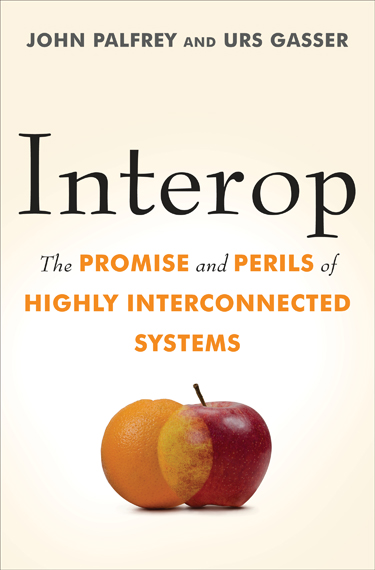 What makes Palfrey & Gasser’s book so important is that the authors aim to develop “a normative theory identifying what we want out of all this interconnectivity” that the information age has brought us. They correctly note “there is no single, agreed-upon definition of interoperability” and that “there are even many views about what interop is and how it should be achieved.” Generally speaking, they argue increased interoperability — especially among information networks and systems — is a good thing because it “provides consumers greater choice and autonomy,” “is generally good for competition and innovation,” and “can lead to systemic efficiencies.”
What makes Palfrey & Gasser’s book so important is that the authors aim to develop “a normative theory identifying what we want out of all this interconnectivity” that the information age has brought us. They correctly note “there is no single, agreed-upon definition of interoperability” and that “there are even many views about what interop is and how it should be achieved.” Generally speaking, they argue increased interoperability — especially among information networks and systems — is a good thing because it “provides consumers greater choice and autonomy,” “is generally good for competition and innovation,” and “can lead to systemic efficiencies.”
But they wisely acknowledge that there are trade-offs, too, noting that “this growing level of interconnectedness comes at an increasingly high price.” Whether we are talking about privacy, security, consumer choice, the state of competition, or anything else, Palfrey and Gasser argue that “the problems of too much interconnectivity present enormous challenges both for organizations and for society at large.” Their chapter and privacy and security offers many examples, but one need only look around at their own digital existence to realize the truth of this paradox. The more interconnected our information systems become, and the more intertwined our social and economic lives become with those systems, the greater the possibility of spam, viruses, data breaches, and various types of privacy or reputational problems. Interoperability giveth and it taketh away.
Ultimately, however, the authors fail to develop a clear standard for when interoperability is good and when governments should take steps to facilitate or mandate it. They argue that “there is no single form or optimal amount of interoperability that will suit every circumstance” and that “most of the specifics of how to bring interop about [must] be determined on a case-by-case basis. Yet, Palfrey and Gasser also make it clear they want government(s) to play an active role in ensuring optimal interoperability. They say they favor “blended approaches that draw upon the comparative advantages of the private and public sector,” but they argue that government should feel free to tip or nudge interoperability determinations in superior directions to satisfy “the public interest.” “If deployed with skill,” they argue, “the law can play a central role in ensuring that we get as close as possible to optimal levels of interoperability in complex systems.”
The fundamental problem this “public interest” approach to interoperability regulation is that it is no better than the “I-know-it-when-I-see-it” standard we sometimes at work in the realm of speech regulation. It’s an empty vessel, and if it is the lodestar by which policymakers make determinations about the optimal level of interoperability, then it leaves markets, innovators, and consumers subject to the arbitrary whims of what a handful of politicians or regulators think constitutes “optimal interoperability,” “appropriate standards,” and “best available technology.”
In my absurdly long review of their book, I offered an alternative framework that suggests patience, humility, and openness to ongoing marketplace experimentation as the primary public policy virtues that lawmakers should instead embrace. Ongoing marketplace experimentation with technical standards, modes of information production and dissemination, and interoperable information systems, is almost always preferable to the artificial foreclosure of this dynamic process through state action. The former allows for better learning and coping mechanisms to develop while also incentivizing the spontaneous, natural evolution of the market and market responses. The latter (regulatory foreclosure of experimentation) limits that potential.
Defining “optimal interoperability,” is not just difficult as Palfrey and Gasser suggest, but I would argue that it is a pipe dream. Sometimes consumers demanded a certain amount interoperability and they usually get it. But it seems equally obvious that consumers don’t always demand perfect interoperability. Just look at your iPhone or Xbox for proof. Quite often, a lack of interoperability helps firms finance important new products and services while simultaneously ensuring users a tailored and potentially more secure and satisfying experience. Importantly, however, non-interoperability also spurs new forms of innovation from rivals looking to leap-frog the old front-runners. Progress flows from this never-ending cycle of technological change and industrial churn.
In sum, we cannot define or determine “optimal interoperability” in an a priori fashion; only ongoing experimentation can help us determine what truly lies in “the public interest.” Despite my different approach and conclusions, Palfrey and Gasser’s book perfectly frames what should be a very interesting ongoing debate over these issues and for that reason will be required reading on this subject for years to come.
Again, my longer review of Palfrey and Gasser’s book can be found here, and listen to John Palfrey’s podcast discussion with Jerry Brito here.]
(4) Christopher Yoo – The Dynamic Internet: How Technology, Users, and Businesses are Transforming the Network
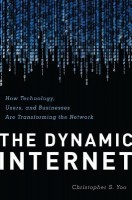 Christopher Yoo’s book was my personal favorite of the year, but it won’t capture as much interest and recognition as some of the other titles on this list. The book offers a concise overview of how Internet architecture has evolved and a principled discussion of the public policies that should govern the Net going forward. Yoo makes two straight-forward arguments. First, the Internet is changing. In Part 1 of the book, Yoo offers a layman-friendly overview of the changing dynamics of Internet architecture and engineering. He documents the evolving nature of Internet standards, traffic management and congestion policies, spam and security control efforts, and peering and pricing policies. He also discusses the rise of peer-to-peer applications, the growth of mobile broadband, the emergence of the app store economy, and what the explosion of online video consumption means for ongoing bandwidth management efforts. Those are the supply-side issues. Yoo also outlines the implications of changes in the demand-side of the equation, such as changing user demographics and rapidly evolving demands from consumers. He notes that these new demand-side realities of Internet usage are resulting in changes to network management and engineering, further reinforcing changes already underway on the supply-side.
Christopher Yoo’s book was my personal favorite of the year, but it won’t capture as much interest and recognition as some of the other titles on this list. The book offers a concise overview of how Internet architecture has evolved and a principled discussion of the public policies that should govern the Net going forward. Yoo makes two straight-forward arguments. First, the Internet is changing. In Part 1 of the book, Yoo offers a layman-friendly overview of the changing dynamics of Internet architecture and engineering. He documents the evolving nature of Internet standards, traffic management and congestion policies, spam and security control efforts, and peering and pricing policies. He also discusses the rise of peer-to-peer applications, the growth of mobile broadband, the emergence of the app store economy, and what the explosion of online video consumption means for ongoing bandwidth management efforts. Those are the supply-side issues. Yoo also outlines the implications of changes in the demand-side of the equation, such as changing user demographics and rapidly evolving demands from consumers. He notes that these new demand-side realities of Internet usage are resulting in changes to network management and engineering, further reinforcing changes already underway on the supply-side.
Yoo’s second point in the book flows logically from the first: as the Internet continues to evolve in such a highly dynamic fashion, public policy must as well. Yoo is particularly worried about calls to lock in standards, protocols, and policies from what he regards as a bygone era of Internet engineering, architecture, and policy. “The dramatic shift in Internet usage suggests that its founding architectural principles form the mid-1990s may no longer be appropriate today,” he argues. “[T]he optimal network architecture is unlikely to be static. Instead, it is likely to be dynamic over time, changing with the shifts in end-user demands,” he says. Thus, “the static, one-size-fits-all approach that dominates the current debate misses the mark.”
Yoo makes a particular powerful case for flexible network pricing policies. His outstanding chapter on “The Growing Complexity of Internet Pricing” offers an excellent overview of the changing dynamics of pricing in this arena and explains why experimentation with different pricing methods and business models must be allowed to continue. Getting pricing right is essential, Yoo notes, if we hope to ensure ongoing investment in new networks and services. He also notes how foolish it is to expect the government to come in and save the day thought massive infrastructure investment to cover the hundreds of billions of dollars needed to continue to build-out high-speed services.
Throughout the second half of his book, Yoo explains why it would be a disaster for consumers and high-tech innovation if policymakers limited pricing flexibility and experimentation with new business models and technological standards. He argues that public policy should generally seek to avoid ex ante forms of preemptive, prophylactic Internet regulation and instead rely on an ex post approach when and if things go wrong. Essentially, he wants policymakers to embrace “techno-agnosticism” toward ongoing debates over standards, protocols, business models, pricing methods, and so on. Lawmakers should not be preemptively tilting the balance in one direction or the other or, worse yet, restricting experimentation that can help us find superior solutions.
And even under that model of retrospective review, Yoo makes it clear throughout the book that there should be a very high bar established before any regulation is pursued. This is particularly true because of the First Amendment values at stake when the government attempts to regulate speech platforms. In Chapter 9 of the book, Yoo walks the reader through all the relevant case law on this front and makes it clear how “the Supreme Court has repeatedly recognized that the editorial discretion exercised by intermediaries serves important free speech values.” Yoo also makes the case that a certain degree of intermediation helps serve consumer needs by helping them more easily find the content and services they desire. Law should not seek to constrain that and, under current Supreme Court First Amendment jurisprudence, it probably cannot.
To me, Yoo’s approach strikes the right balance for Net governance and public policy in the information age. It all comes down to flexibility and freedom. If the Internet and all modern digital technologies are to thrive, we must reject the central planner’s mindset that dominated the analog era and forever bury all the static thinking it entailed.
My complete review of Yoo’s Dynamic Internet is here.
(5) Brett Frischmann – Infrastructure: The Social Value of Shared Resources
 Frischmann’s book offers a nice contrast with Yoo’s in that it suggests a far more ambitious role for the state in shaping the future of digital networks and online platforms. Although not strictly a book about information technology infrastructure, Frischmann spends a great deal of time making the case for a greater government action in the realm of communications policy and for open access and Net neutrality regulation in particular. (There’s also a chapter on intellectual property issues that tech policy wonks will find of interest). The book is a veritable paean to open access regulation; Frischmann aims to persuade the reader that “society is better off sharing infrastructure openly” and devotes considerable energy to hammering that point home in one context after another.
Frischmann’s book offers a nice contrast with Yoo’s in that it suggests a far more ambitious role for the state in shaping the future of digital networks and online platforms. Although not strictly a book about information technology infrastructure, Frischmann spends a great deal of time making the case for a greater government action in the realm of communications policy and for open access and Net neutrality regulation in particular. (There’s also a chapter on intellectual property issues that tech policy wonks will find of interest). The book is a veritable paean to open access regulation; Frischmann aims to persuade the reader that “society is better off sharing infrastructure openly” and devotes considerable energy to hammering that point home in one context after another.
In my review of the book, which was part of 2-day symposium on the book over at the Concurring Opinions blog, I took Frischmann’s book to task for its almost complete absence of public choice insights and his general disregard for thorny “supply-side” questions. Frischmann is so single-mindedly focused on making the “demand-side” case for better appreciating how open infrastructures “generate spillovers that benefit society as a whole” and facilitate various “downstream productive activities,” that he short-changes the supply-side considerations regarding how infrastructure gets funded and managed to begin with.
The book also ignored the omnipresent threat of regulatory capture and the fact that any major infrastructure regulatory system big enough and important to be captured by special interests and affected parties often will be. Frischmann acknowledges the problem of capture in just a single footnote in the book and admits that “there are many ways in which government failures can be substantial,” but he asks the reader to quickly dispense with any worries about government failure since he believes “the claims rest on ideological and perhaps cultural beliefs rather than proven theory or empirical fact.” I found that assertion outrageous and argued that, to the contrary, decades of scholarship has empirically documented the reality of government failure and its costs to society, as well as the plain old-fashioned inefficiency often associated with large-scale government programs. For infrastructure projects in particular, the combination of these public choice factors usually adds up to massive inefficiencies and cost overruns.
For those reasons, I argued in my review that society would be better off adopting a “3-P” approach to infrastructure management: privatize, property-tize, and price. But Frischmann is dead set against such thinking and makes it clear that everything must be subservient to the goal of “openness” and commons-based management. Unsurprisingly, therefore, this leads him to suggest that we need “a dramatic shift — perhaps a paradigm shift — away from the conventional position favoring market provisioning and markets ‘free’ from government intervention.” But the problem with that reasoning, as I pointed out in my review, is that most of the infrastructure that Frischmann cites as failing us today is already managed in the fashion he favors! Nonetheless, he wants to pile on still more commons-based government control / ownership solutions even though they are the primary cause of our infrastructure problems today. In this sense, Frischmann’s approach parallels Susan Crawford’s in her book Captive Audience, discussed above. They both seek to gloss over the ugly realities of traditional public infrastructure (mis-)management and they imply that we just need to build a better breed of bureaucrats who will somehow be immune to all the problems of the past. Needless to say, I don’t place much faith in such efforts.
Despite these serious deficiencies, students and scholars studying infrastructure theory will benefit from Frischmann’s excellent treatment of public goods and social goods; spillovers and externalities; proprietary versus commons systems management; common carriage policies and open access regulation; congestion pricing strategies; and the debate over price discrimination for infrastructural resources. He at least does a nice job outlining these concepts and controversies, even if he ultimately fails to make the case for radically expanding government control of infrastructural resources.
Again, you can read my entire review of Frischmann’s book here.
________________
— Other Major Releases in 2012 —
Julie E. Cohen – Configuring the Networked Self: Law, Code, and the Play of Everyday Practice
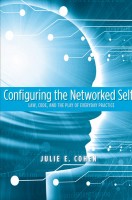 Cohen’s book represents an effort to move “beyond the bounds of traditional liberal political theory” by transcending what she labels the traditional “information-as-freedom” versus “information-as-control” paradigms. Her aim is to promote “cultural environmentalism” and “the structural conditions of human flourishing.” She argues that “a commitment to human flourishing demands a more critical stance toward the market-driven evolution of network architectures.” In other words, don’t trust markets.
Cohen’s book represents an effort to move “beyond the bounds of traditional liberal political theory” by transcending what she labels the traditional “information-as-freedom” versus “information-as-control” paradigms. Her aim is to promote “cultural environmentalism” and “the structural conditions of human flourishing.” She argues that “a commitment to human flourishing demands a more critical stance toward the market-driven evolution of network architectures.” In other words, don’t trust markets.
I didn’t find her case very convincing and it didn’t help that the book is filled with impenetrable prose that sometimes leaves the reader’s head a bit numb. (Two representative samples: “With respect to space, surveillance employs a twofold dynamic of containerization and affective modulation in order to pursue large-scale behavioral modification.” … and… “Here the performative impulse introduces static into the circuits of the surveillant assemblage; it seeks to reclaim bodies and reappropriate spaces.” Say what? Write in plain English, professor!)
The closing chapter also includes a strange reinterpretation of Ludditism. Cohen argues: “the tale of the Luddites poses an important challenge for scholars and policy makers in the emerging networked information society. If technologies do not have natural trajectories, it is our obligation to seek pathways of development that promote the well-being of situated, embodied users and communities. When our preferred policy prescriptions persistently produce information architectures and institutions that undermine human flourishing in critical ways, it is time to question them and to experiment with ways of doing better.” Hmmm… I’m not sure I want to know what that would mean in practice!
Regardless, Cohen’s book has a lot to say about modern privacy and copyright battles and will be of great interest to scholars in those specific fields of study. You can find all the chapters online here.
Cole Stryker – Hacking the Future: Privacy, Identity, and Anonymity on the Web
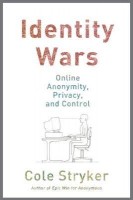 Stryker’s Hacking the Future provides a concise overview of the battles over online anonymity that have raged since the Net’s early days and he outlines the many new threats to it. “What we are seeing is an all-out war on anonymity, and thus free speech, waged by a variety of armies with widely diverse motivations, often for compelling reasons,” he says. The book will be a great use to those covering ongoing policy debates over cybersecurity, the “nymwars” and online authentication / identification debates, post-Arab Spring political activism & “hactivism,” encryption issues, social networking privacy, troll culture and cyberbullying, and much more. Stryker makes a strong case for the continuing importance of online anonymity but isn’t scared to ask hard questions about the trade-offs society faces when some can mask their online identities. But he also explores the question of whether anonymity can survive given recent technological and policy-related developments, both of which aim to make individuals more identifiable online. I particularly enjoyed Chapter 10’s breakdown of the “Faces of Anonymity,” in which Stryker crafts a detailed taxonomy of anonymous character types online.
Stryker’s Hacking the Future provides a concise overview of the battles over online anonymity that have raged since the Net’s early days and he outlines the many new threats to it. “What we are seeing is an all-out war on anonymity, and thus free speech, waged by a variety of armies with widely diverse motivations, often for compelling reasons,” he says. The book will be a great use to those covering ongoing policy debates over cybersecurity, the “nymwars” and online authentication / identification debates, post-Arab Spring political activism & “hactivism,” encryption issues, social networking privacy, troll culture and cyberbullying, and much more. Stryker makes a strong case for the continuing importance of online anonymity but isn’t scared to ask hard questions about the trade-offs society faces when some can mask their online identities. But he also explores the question of whether anonymity can survive given recent technological and policy-related developments, both of which aim to make individuals more identifiable online. I particularly enjoyed Chapter 10’s breakdown of the “Faces of Anonymity,” in which Stryker crafts a detailed taxonomy of anonymous character types online.
He also offers a run-down of the tools and steps that people can take advantage of if they want to ensure their anonymity / privacy online, including: cookie blocking, private browsing tools, disabling HTML in email and limiting or disabling broswer extensions, clearing browser histories, and using encryption tools, proxy servers, and VPN tunneling. “The question we have to ask ourselves,” Stryker notes, is “Does the accessibility of these anonymizing technologies make the world a safer, more equitable place, better place?” He answers: “It’s difficult to measure, but their abolition certainly wouldn’t.” He also draws this interesting parallel with efforts to regulate firearms: “The logic here is not unlike that used by those who oppose gun control: if guns are made illegal, then only criminals will have guns, leaving well-meaning folks defenseless. The reasoning is compelling within the identity space,” he argues, “regardless of what you might think about the merits of gun control.”
Two other notes: First, Wide Open Privacy: Strategies For The Digital Life by J.R. Smith & Siobhan MacDermott makes a nice compliment to Hacking the Future. It also offers a breakdown of privacy-enhancing technologies and outlines other strategies to safeguard your online anonymity. Second, if you are interested in digging even deeper in the Luzsec side of this story, you should check out Parmy Olson’s We are Anonymous: Inside the Hacker World of Lulzsec, Anonymous and the Global Cyber Insurgency. It’s a splendid history but doesn’t have as much to say about the various policy issues that Stryker tackles in Hacking the Future. Or just listen to Olson’s podcast discussion with Jerry Brito. Speaking of that Brito character…
Jerry Brito (ed.) – Copyright Unbalanced: From Incentive to Excess
 My Mercatus Center colleague Jerry Brito put together this important collection of essays by various conservatives and libertarian authors to highlight growing concerns about copyright policy. Contributors include Tom W. Bell, David G. Post, Reihan Salam, Patrick Ruffini, Tim Lee, Christina Mulligan, and Eli Dourado (also of Mercatus). Their essays suggest that the tide may be turning against copyright among free market analysts. Their chapters explore the increasingly complexity of copyright law and the rising costs associated with its enforcement and make a powerful case for reform of, or at least restraints on, the current copyright system. The consensus seemed to revolve around a few key reforms: significantly shortened copyright terms, the reintroduction of formalities (i.e., registration), and limits on criminal prosecution and civil asset forfeiture. The authors also make a strong case that public choice problems pervade today’s copyright system and that we should be concerned that cronyism is increasing creeping into the politics of copyright law and its seemingly endless expansion.
My Mercatus Center colleague Jerry Brito put together this important collection of essays by various conservatives and libertarian authors to highlight growing concerns about copyright policy. Contributors include Tom W. Bell, David G. Post, Reihan Salam, Patrick Ruffini, Tim Lee, Christina Mulligan, and Eli Dourado (also of Mercatus). Their essays suggest that the tide may be turning against copyright among free market analysts. Their chapters explore the increasingly complexity of copyright law and the rising costs associated with its enforcement and make a powerful case for reform of, or at least restraints on, the current copyright system. The consensus seemed to revolve around a few key reforms: significantly shortened copyright terms, the reintroduction of formalities (i.e., registration), and limits on criminal prosecution and civil asset forfeiture. The authors also make a strong case that public choice problems pervade today’s copyright system and that we should be concerned that cronyism is increasing creeping into the politics of copyright law and its seemingly endless expansion.
If you interested in a different take on IP issues to balance out Brito’s collection, I’d recommend picking up the forthcoming Laws of Creation: Property Rights in the World of Ideas by Ronald A. Cass and Keith N. Hylton. It’s a 2013 release but it is already in stock. I’m reading an advance copy from the publisher right now and will likely have more to say about it in a forthcoming post.
Randolph J. May (ed.) – Communications Law and Policy in the Digital Age: The Next Five Years
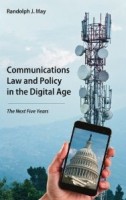 My former colleague Randy May put together this nice collection of essays by some of America’s leading communications and media policy scholars, including Bruce Owen, Christopher Yoo, James Speta, Daniel Lyons and others. The authors offer a generally skeptical take on the expansion of communications and broadband regulation and the growing power of the Federal Communications Commission over these markets. In particular, many of the contributors take the FCC to task for sketchy assertions of jurisdiction and the agency’s efforts to expand its imperial regulatory ambitions without always having the clear statutory authority to do so. The chapters by James Speta and Seth Cooper are particularly good in that regard. Admin law geeks will eat them up.
My former colleague Randy May put together this nice collection of essays by some of America’s leading communications and media policy scholars, including Bruce Owen, Christopher Yoo, James Speta, Daniel Lyons and others. The authors offer a generally skeptical take on the expansion of communications and broadband regulation and the growing power of the Federal Communications Commission over these markets. In particular, many of the contributors take the FCC to task for sketchy assertions of jurisdiction and the agency’s efforts to expand its imperial regulatory ambitions without always having the clear statutory authority to do so. The chapters by James Speta and Seth Cooper are particularly good in that regard. Admin law geeks will eat them up.
Those analysts following the ongoing Net neutrality wars will also find the book informative, even if they disagree with the generally skeptical take on the issue from contributors. Spectrum and universal service policy wonks will also appreciate the excellent chapters on those two issues from Michele P. Connolly and Daniel A. Lyons, respectively. And the closing chapter by Bruce Owen is, like everything Bruce does, a masterpiece. Owen is probably the most respected media economist on the planet and his decades of experience in this field shines through in his powerful essay on “Communications Policy Reform, Interest Groups, and Legislative Capture.” He crafts a political economy of the regulatory state and points out that the explosion of rent-seeking and legislative/regulatory capture in this sector is unlikely to dissipate. “Therefore,” Owen argues, “communications policy likely will continue to be subject to welfare-suppressing regulation because such regulation is consistent with the interests of legislators,” who are often beholden to special interests and their campaign dollars.
Joshua Gans – Information Wants to Be Shared
 I really enjoyed this book. It’s an insightful exploration of modern media economics filled with interesting questions and scenarios about how information markets will evolve in the future. What will sustain movies, music, book, local reporting, and so on in the future? Gans does a terrific job making these issues easy to understand and doesn’t try to evangelize as much as the many others who have written on these issues. If you’ve read and enjoyed Carl Shapiro and Hal Varian’s classic text, Information Rules, then you will find Gans’ book to be the perfect compliment.
I really enjoyed this book. It’s an insightful exploration of modern media economics filled with interesting questions and scenarios about how information markets will evolve in the future. What will sustain movies, music, book, local reporting, and so on in the future? Gans does a terrific job making these issues easy to understand and doesn’t try to evangelize as much as the many others who have written on these issues. If you’ve read and enjoyed Carl Shapiro and Hal Varian’s classic text, Information Rules, then you will find Gans’ book to be the perfect compliment.
Gans doesn’t have a lot to say about public policy, however. This is really more of a business book suited for industry analysts and business school students. Nonetheless, some of its implications for policy are clear since many of these business model debates boil over into the policy arena.
P.S. I should mention that, even if you don’t pick up his new book, you should be following Gans’ “Digitopoly” blog. It is always worth reading.
Andrew Keen – Digital Vertigo: How Today’s Online Social Revolution Is Dividing, Diminishing, and Disorienting Us
 If you’re into ‘the-whole-world-is-going-to-Hell-and-the-Internet-is-to-blame’ screeds, Andrew Keen will never disappoint. In Digital Vertigo as well as his earlier book, The Cult of the Amateur, Keen is grumpy about, well, just about everything under the sun. In the earlier book, it was the Web 2.0 world of blogging and “amateur” content creation — most notably Wikipedia and YouTube — that earned Keen’s wrath. In the new book, it is users themselves and the social sharing sites and technologies that they favor that Keen goes off on.
If you’re into ‘the-whole-world-is-going-to-Hell-and-the-Internet-is-to-blame’ screeds, Andrew Keen will never disappoint. In Digital Vertigo as well as his earlier book, The Cult of the Amateur, Keen is grumpy about, well, just about everything under the sun. In the earlier book, it was the Web 2.0 world of blogging and “amateur” content creation — most notably Wikipedia and YouTube — that earned Keen’s wrath. In the new book, it is users themselves and the social sharing sites and technologies that they favor that Keen goes off on.
Specifically, Keen is worried that our increased reliance on new online and interactive technologies is spawning a “hypervisible age of great exhibitionism” that sacrifices privacy and individuality at the altar of sharing and social status-seeking. He also makes sweeping claims that we are now living in “a world in which many of us have forgotten what it means to be human,” or that “we are forgetting who we really are.” As I noted in my Forbes review of the book, it’s classic technopanic talk. Not only does Keen fail to substantiate such claims, but he also doesn’t bother to even offer the reader any sort of practical plan for how to achieve a more balanced digital life.
Bruce Schneier – Liars & Outliers: Enabling the Trust that Society Needs to Thrive
 Security expert Bruce Schneier’s latest book was a terrific read and easily one of my favorites of the year. It wasn’t a book about technology policy per se, but it certainly has important ramifications for it. Schneier explains four “societal pressures” combine to help create and preserve trust within society. Those pressures include: (1) Moral pressures; (2) Reputational pressures; (3) Institutional pressures; and (4) Security systems. By “dialing in” these societal pressures in varying degrees, trust is generated over time within groups. Of course, these societal pressures also fail on occasion, Schneier notes. He explores a host of scenarios — in organizations, corporations, and governments — when trust breaks down because defectors seek to evade the norms and rules the society lives by. These defectors are the “liars and outliers” in Schneier’s narrative and his book is an attempt to explain the complex array of incentives and trade-offs that are at work and which lead some humans to “game” systems or evade the norms and rules others follow.
Security expert Bruce Schneier’s latest book was a terrific read and easily one of my favorites of the year. It wasn’t a book about technology policy per se, but it certainly has important ramifications for it. Schneier explains four “societal pressures” combine to help create and preserve trust within society. Those pressures include: (1) Moral pressures; (2) Reputational pressures; (3) Institutional pressures; and (4) Security systems. By “dialing in” these societal pressures in varying degrees, trust is generated over time within groups. Of course, these societal pressures also fail on occasion, Schneier notes. He explores a host of scenarios — in organizations, corporations, and governments — when trust breaks down because defectors seek to evade the norms and rules the society lives by. These defectors are the “liars and outliers” in Schneier’s narrative and his book is an attempt to explain the complex array of incentives and trade-offs that are at work and which lead some humans to “game” systems or evade the norms and rules others follow.
Indeed, Schneier’s book serves as an excellent primer on game theory as he walks readers through complex scenarios such as prisoner’s dilemma, the hawk-dove game, the free-rider problem, the bad apple effect, principle-agent problems, the game of chicken, race to the bottom, capture theory, and more. These problems are all quite familiar to economists, psychologists, and political scientists, who have spent their lives attempting to work through these scenarios. Schneier has provided a great service here by making game theory more accessible to the masses and given it practical application to a host of real-world issues.
The most essential lesson Schneier teaches us is that perfect security is an illusion, and this is where the implications for tech policy come in. We can rely on those four societal pressures in varying mixes to mitigate problems like theft, terrorism, fraud, online harassment, and so on, but it would be foolish and dangerous to believe we can eradicate such problems completely. “There can be too much security,” Schneier explains, because, at some point, constantly expanding security systems and policies will result in rapidly diminishing returns. Trying to eradicate every social pathology would bankrupt us and, worse yet, “too much security system pressure lands you in a police state,” he correctly notes.
Despite these challenges, Schneier reminds us that there is cause for optimism. Humans adapt better to social change than they sometimes realize, usually by tweaking the four societal pressures Schneier identifies until a new balance emerges. While liars and outliers will always exist, society will march on.
See my longer review of Schneier’s excellent book over at Forbes. I highly recommend you pick up Liars & Outliers no matter what your field of study. It is outstanding.
________________
… and still more titles from 2012 (* asterisk means I didn’t find time to finish them)…
- E. Gabriella Coleman – Coding Freedom: The Ethics and Aesthetics of Hacking *
- Sean A. Pager & Adam Candeub (eds.) – Transnational Culture in the Internet Age *
- John Naughton – From Gutenberg to Zuckerberg: What You Really Need to Know about the Internet
- Erik Brynjolfsson & Andrew McAfee – Race Against the Machine: How the Digital Revolution is Accelerating Innovation, Driving Productivity, and Irreversibly Transforming Employment and the Economy [listen to McAfee’s podcast discussion with Jerry Brito]
- Chris Reed – Making Laws for Cyberspace *
- J.R. Smith & Siobhan MacDermott – Wide Open Privacy: Strategies For The Digital Life
- Virginia Eubanks – Digital Dead End: Fighting for Social Justice in the Information Age *
- Lori Andrews – I Know Who You Are and I Saw What You Did: Social Networks and the Death of Privacy
- Hassan Masum and Mark Tovey (eds.) – The Reputation Society: How Online Opinions Are Reshaping the Offline World *
- Reed Hundt & Blair Levin – The Politics of Abundance: How Technology Can Fix the Budget, Revive the American Dream, and Establish Obama’s Legacy *
- Kal Raustiala & Christopher Sprigman – The Knockoff Economy: How Imitation sparks Innovation* [listen to Sprigman’s podcast discussion with Jerry Brito]
- Jason Mazzone, Copyfraud and Other Abuses of Intellectual Property Law * [listen to Mazzone’s podcast discussion with Jerry Brito]
- Clay A. Johnson – The Information Diet: A Case for Conscious Consumption
- Julian Assange – Cypherpunks: Freedom and the Future of the Internet
- Andy Greenberg – This Machine Kills Secrets: How WikiLeakers, Cypherpunks, and Hacktivists Aim to Free the World’s Information
… and, again, here are the lists of important books from 2008, 2009, 2010, and 2011.
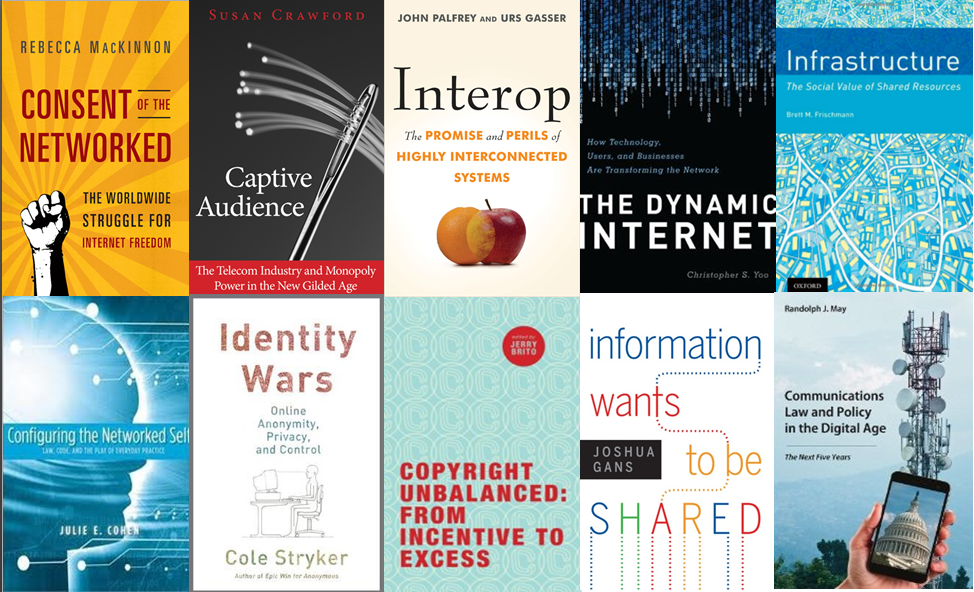

 The Technology Liberation Front is the tech policy blog dedicated to keeping politicians' hands off the 'net and everything else related to technology.
The Technology Liberation Front is the tech policy blog dedicated to keeping politicians' hands off the 'net and everything else related to technology.